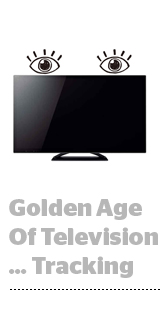 The Federal Trade Commission is watching smart TVs.
The Federal Trade Commission is watching smart TVs.
An FTC workshop on Wednesday in Washington, DC, laid out consumer privacy concerns around smart-TV tracking and sought to clarify how the ad industry is using the data that’s being collected.
“Consumers expect some level of data collection when they use their computer,” said Jessica Rich, director of the FTC’s Bureau of Consumer Protection. “[But] many consumers have a fundamentally different relationship with their television than their computer.”
And that raises questions for the FTC, Rich said, namely how to ensure that the benefits of smart TVs outweigh the risks.
There’s more choice than ever and smart TVs are clever enough to learn a user’s viewing preferences and recommend content accordingly. But as television buyers go beyond basic age and gender demography and start adopting more digitally inspired advanced targeting tactics, it’s unclear whether consumers are aware that as they’re watching their TVs, their TVs are watching them.
Smart TVs are connected to the web, which means they’re able to collect and transmit a host of different data signals, everything from the specific content viewers are viewing and when they’re viewing it to what channel it’s on and how much of it they viewed. That data can then be used to target them with ads across devices.
Samsung, for example, has been beta testing an addressable ad product that taps smart-TV data to target ads across linear television broadcasts.
“As long as the data is anonymized, there shouldn’t be any problem,” said Mark Risis, former head of strategy and business development at Tivo Research and currently VP of partnerships at The Weather Co.
Smart-TV consumption data can be used power content recommendations and help users navigate the ever-growing sea of choice and channels. It can lead to shorter commercial breaks, he said.
The average ad load on broadcast TV is around 18 minutes per content hour, Risis said, whereas Hulu can afford a far shorter ad load, about two or three minutes for every 60, because it’s pushing more relevant ads and controlling for frequency.
The privacy issue crops up when viewing data is connected to PII or a consumer ID is exposed.
“It’s not the data, it’s the person that should be protected in the most strenuous way possible,” Risis said.
How to actually accomplish that is another matter.
“From the moment we bought our first personal computer, there was data collection and data-driven advertising,” Rich said. “By contrast, the television industry didn’t evolve with data collection as a critical component.”
For one, consumers aren’t expecting to be presented with an on-screen opt-in notice when they’re setting up their TV, which is the current preferred mode of notice and choice for smart-TV manufacturers, though that’s likely to change as the technology evolves.
Better safe than sorry, though, said Ashwin Navin, CEO of Samba TV, an IPG-backed smart-TV data, analytics and recommendation platform.
“When a consent form shows up on your television, it’s jarring, but what’s more jarring is showing up to a Senate confirmation hearing and they know what you rented from Blockbuster,” Navin said, referring to the Video Privacy Protection Act, a now-antiquated federal law passed in 1988 that restricts what video providers can share with third parties without a user’s explicit consent.
The VPPA, known colloquially as the Bork Law after Robert Bork, who had his video rental history published during his Supreme Court nomination process, is supporting a class-action lawsuit against smart-TV manufacturer Vizio, which is accused of collecting and reselling television viewership data by default.
It’s not clear yet whether the Bork Law will be the most effective regulatory cudgel to keep smart-TV manufacturers and streaming-service providers in line.
The Network Advertising Initiative, a self-reg body for third-party ad tech companies, convened a smart-TV working group about a year and a half ago to get more familiar with the technology and start working toward best practices and privacy principles for the industry to rally around.
“It’s a work in progress,” said Shaq Katikala, the NAI’s counsel and assistant director of technology and data science.
But from a smart-TV standpoint, I don’t think it’s any surprise to people that TVs are connected nowadays,” he said. “Consumers might have questions about what data is collected, but [they have expectations about data collection from the mobile app world], and we’re looking to draw models from there and apply them to smart TVs.”
As the internet and television continue to merge and the industry endeavors to hammer out a self-regulatory regime for smart TVs, the FTC will stay tuned into its efforts.
“It matters whether consumers think of their smart TV as a computer or a television and whether they recognize that today it may be both,” Rich said. “We’ve been watching this area since its infancy and we’ve made it clear that the same basic consumer protection rules apply.”
This post was syndicated from Ad Exchanger.

More Stories
Nielsen’s The Gauge Streaming Ratings for March 2025
New pDOOH packs from MediaWorks deliver instant reach
Week of April 7 Morning News Ratings: Today Celebrates 87 Weeks at the Top of the Demo